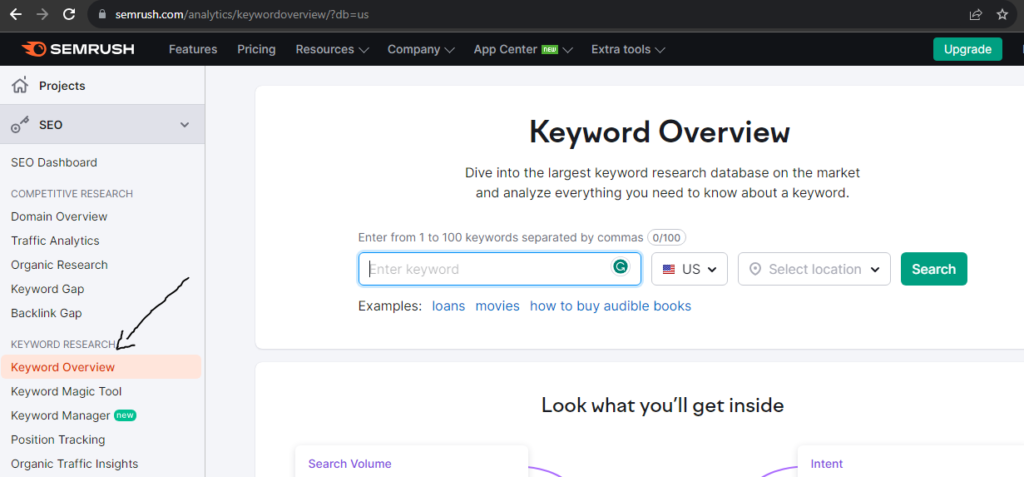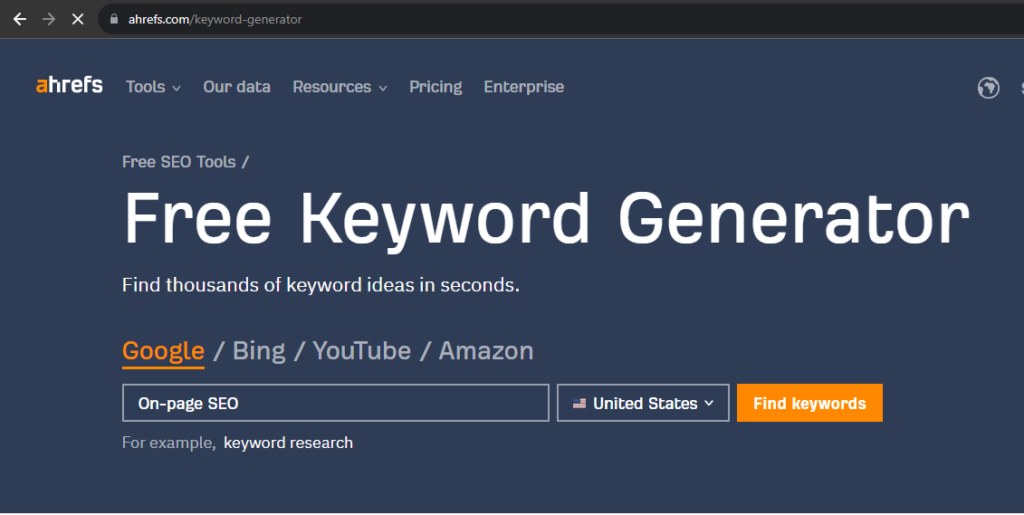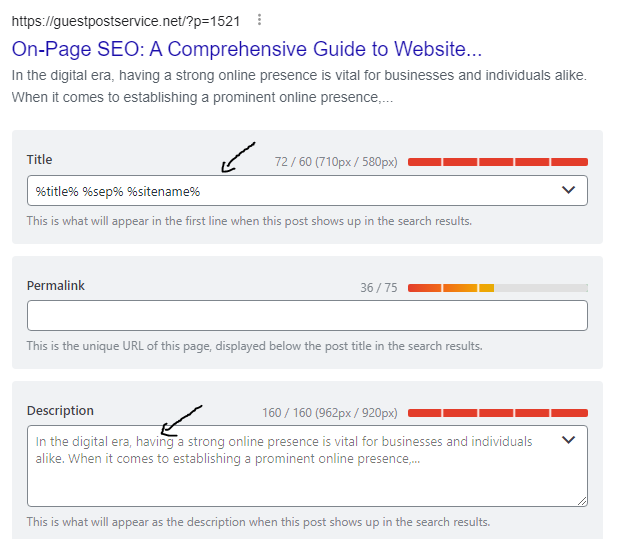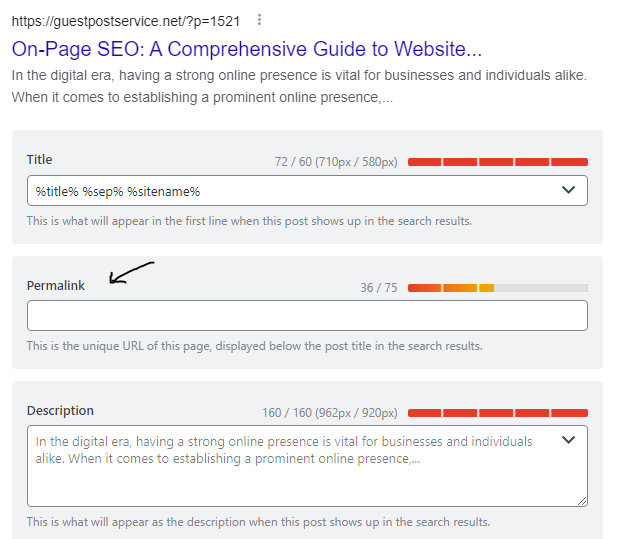In the digital era, having a strong online presence is vital for businesses and individuals alike. When it comes to establishing a prominent online presence, search engine optimization (SEO) plays a crucial role. Within SEO, there are two main types: on-page and off-page SEO. In this ultimate on page seo guide, we’ll delve into the world of on-page SEO and how it can significantly impact the optimization of your website.
Table of Contents
Ultimate On Page SEO Guide 2023
On-page SEO is a fundamental aspect of search engine optimization that revolves around optimizing your website’s individual pages to improve their visibility and ranking on search engine result pages (SERPs). Unlike off-page SEO, which focuses on external factors like relevant backlinks and social signals, on-page SEO involves implementing strategies directly on your website.
The goal of on-page SEO is to make your web pages more appealing and relevant to both search engines and users. By optimizing various elements on your website, you can increase its chances of ranking higher in search results, attracting more organic traffic, and ultimately enhancing user experience. The organic traffic checker free.
By carefully implementing on-page SEO techniques, you can create a well-optimized website that not only ranks higher in search results but also provides a positive and engaging experience for your visitors. It’s important to continuously monitor and update your on-page SEO efforts to adapt to evolving search engine algorithms and user preferences.
Importance of On-Page SEO for Website Optimization
Having a well-optimized website is essential because it improves your chances of ranking higher in search engine results. When your website ranks higher, it will increase organic traffic, which can lead to increased conversions and better business opportunities.
Keyword Research and Selection
Keyword research is a fundamental and vital aspect of developing a successful on-page SEO strategy. It serves as the bedrock upon which your entire optimization efforts will stand. By identifying relevant keywords and phrases, you can effectively reach your target audience and improve your website’s visibility in search engine results.
To start your keyword research, put yourself in your target audience’s shoes and consider what words or phrases they are likely to use when searching for content related to your website. Understanding your audience’s intent is crucial in finding the right keywords that align with their interests and needs.
There are several valuable tools available to aid you in your keyword research journey. Two popular options are Google Keyword Planner and SEMrush. These tools offer valuable insights into the search volume and competition for specific keywords. Balancing search volume and competition is essential; you want keywords that have a decent search volume (indicating popularity) but aren’t excessively competitive, making it difficult for your website to rank for them.
Google Keyword Planner, a free tool provided by Google, allows you to explore keyword ideas, search volume trends, and competition levels for various keywords. It’s an excellent starting point for beginners and provides valuable data directly from the largest search engine.
SEMrush is a powerful keyword research tool that offers more advanced features, including competitor analysis, keyword difficulty metrics, and more comprehensive keyword suggestions. While it does require a subscription, the insights it provides can significantly enhance your keyword research process.

Another valuable tool for conducting keyword research is the free Ahrefs Keyword Researcher. Ahrefs is a widely recognized and trusted SEO tool that offers an extensive database of keywords and search data. The Ahrefs Keyword Researcher allows users to explore keyword ideas, analyze search volumes, assess keyword difficulty, and even view the top-ranking pages for specific keywords. While the free version offers limited features compared to the full Ahrefs suite, it still provides valuable insights that can aid in identifying relevant and high-performing keywords for your on-page SEO strategy. With the help of Ahrefs Keyword Researcher, you can further refine your list of target keywords and make well-informed decisions to boost your website’s visibility and organic traffic.

Once you have identified a list of relevant and valuable keywords, organize them based on relevance and search volume. Prioritize keywords that closely align with your website’s content and business objectives. Remember, the goal is not only to attract more traffic but also to attract the right kind of traffic that is genuinely interested in what you have to offer.
Title Tag and Meta Description Optimization
Title tags and meta descriptions play a critical role in on-page SEO as they are the first elements users encounter in search engine results. To optimize these elements effectively, it’s essential to create compelling and concise title tags that incorporate the primary keyword for each page. The title tag should accurately represent the content and topic of the page while enticing users to click and explore further. By including the primary keyword, you signal to search engines what the page is about, improving its chances of ranking for relevant searches.

Equally important are meta descriptions, which provide a brief summary of the page’s content. Write engaging meta descriptions that entice users to click on your link by highlighting the unique value or information offered on the page. While meta descriptions don’t directly impact search rankings, they can significantly impact click-through rates. A well-crafted meta description encourages users to visit your website, even if it might not be the top-ranked result, increasing your chances of attracting organic traffic and potential customers.
Remember that both title tags and meta descriptions should be unique for each page of your website, accurately reflecting the content and value of that specific page. Crafting compelling and optimized title tags and meta descriptions will not only improve your website’s search engine visibility but also enhance user engagement and overall user experience. Invest time in this optimization process, and you’ll see better results in terms of search rankings and click-through rates.
URL Structure and Permalink Optimization
URL structure and permalink optimization are essential aspects of on-page SEO that can significantly impact your website’s search engine rankings and user experience. When crafting URLs, it’s crucial to prioritize user-friendliness and relevance.

Create descriptive URLs that give users and search engines a clear idea of the page’s content. Incorporate the target keyword if possible, as this helps signal the page’s topic to search engines and improves its chances of ranking for relevant searches. However, avoid keyword stuffing and keep the URL concise and focused.
Long and complex URLs can confuse both search engines and users, making it challenging to understand the page’s content at a glance. To avoid this, use hyphens to separate words within the URL and eliminate unnecessary characters or numbers that do not add value.
Permalinks, which are permanent URLs that point to individual pages on your website, should be optimized to reflect the title of the content accurately. This creates consistency between the URL and the content, making it easier for users to remember and share the link.
By optimizing your URL structure and permalinks, you create a more user-friendly and search engine-friendly website. Clear, descriptive, and concise URLs improve the overall user experience, increase the chances of higher search engine rankings, and make it easier for users to share and revisit your content.
Header Tags (H1, H2, H3, and H4) Optimization
Header tags, including H1, H2, H3, and H4, play a crucial role in organizing your content and providing a clear hierarchy of information on your web page. When optimizing header tags, it’s essential to follow best practices to enhance both user experience and search engine visibility.
The H1 tag should be reserved for the main title of your page. It serves as the primary heading and should succinctly convey the main topic or focus of the content. Incorporating relevant keywords into the H1 tag helps search engines understand the primary subject matter and context of the page.
Subsequent sections or subheadings within your content should be marked with H2, H3, and H4 tags to create a logical structure. These subheadings divide your content into easily digestible sections, making it more user-friendly and scannable. By using H2, H3, and H4 tags, you establish a clear hierarchy of information, indicating which points are more important or serve as subsections of others.
Just like with the H1 tag, incorporating relevant keywords into the subheadings helps search engines better comprehend the content’s structure and topic distribution. However, avoid overusing keywords and prioritize creating descriptive and meaningful headings that accurately represent the content under each section.
Proper header tag optimization not only benefits search engine crawlers but also enhances the user experience. Clear and well-structured headings make it easier for visitors to navigate your content, find relevant information, and understand the flow of the page. This, in turn, leads to increased engagement and lower bounce rates, signaling search engines that your content is valuable and relevant to users’ queries.
Content Optimization and Keyword Placement
Crafting high-quality, informative, and engaging content is essential for any content marketing strategist. When creating content, it’s crucial to keep your target audience in mind and deliver value to meet their needs effectively. To optimize your content for search engines, you should strategically incorporate your target keywords throughout the text.
When using keywords in your content, remember to do so naturally and seamlessly. Avoid overstuffing your content with keywords, as this can be perceived as keyword spamming by search engines, which may lead to a negative impact on your rankings.
Here are some tips to effectively place your keywords within your content:
Title: Include your primary target keyword in the title of your content. This will signal the topic of your piece to both readers and search engines.
Introduction: Introduce your content with a captivating opening that includes one or more of your target keywords. This will help set the context for your readers and improve your content’s relevance.
Body: Sprinkle your target keywords naturally throughout the body of your content. Use variations and synonyms of your keywords to make the content flow more smoothly.
Subheadings: When appropriate, incorporate your keywords into subheadings (H2, H3, H4) to organize your content and provide additional context for search engines.
Conclusion: Include your target keywords in the concluding section of your content. This reinforces the main points and helps reinforce the topic for search engines.
Remember, the key to effective keyword placement is to prioritize readability and user experience. Your content should feel natural and engaging to readers, and keywords should seamlessly fit into the overall narrative.
By following these content optimization and keyword placement strategies, you can enhance your content marketing efforts and improve your chances of ranking higher in search engine results. Providing valuable, relevant, and keyword-optimized content will attract your target audience and establish you as an authority in the content marketing world.
Implement these tips, and your content marketing strategy will be well on its way to success, attracting more visitors and driving better engagement.
Image Optimization
Image optimization is a crucial aspect of on-page SEO that can significantly impact your website’s performance and user experience. By following best practices for image optimization, you can ensure that your website loads quickly and efficiently while still providing high-quality visuals.
One of the primary techniques for image optimization is compression. Compressing images reduces their file size without compromising on visual quality. Smaller image file sizes lead to faster page loading times, which is essential for improving user satisfaction and search engine rankings. There are various image compression tools available online that can help you achieve this optimization without sacrificing image clarity.
Another important element of image optimization is the use of descriptive alt text and file names. Alt text provides a textual description of the image, which is essential for accessibility. Screen readers use alt text to describe images to visually impaired users, making your website more inclusive and user-friendly. Additionally, search engines use alt text to understand the content of the image, which can improve your website’s relevance in search results.
When writing alt text, be descriptive and concise, and include relevant keywords when appropriate. However, avoid keyword stuffing and focus on accurately describing the image’s content and purpose. Similarly, when naming image files, use descriptive file names that reflect the image’s content. This provides additional context to search engines and reinforces the relevance of the image to your overall content.
By optimizing your images through compression and using descriptive alt text and file names, you can create a more efficient and user-friendly website. Faster loading times and improved accessibility contribute to a better user experience, leading to higher user engagement and potentially better search engine rankings.
Internal Linking Strategy
Create a strategic internal linking structure to help search engines discover and index your content more effectively. Internal links also aid users in navigating your website, increasing the time they spend on your pages and reducing bounce rates.
Mobile-Friendly Optimization
In today’s mobile-driven world, having a mobile-friendly website is no longer an option but a necessity. Ensure that your website is responsive and offers a seamless experience across different devices, as Google considers mobile-friendliness as a ranking factor.
Page Loading Speed and Performance
Page loading speed directly impacts user experience and search engine rankings. Optimize your website’s performance by reducing server response time, leveraging browser caching, and using optimized images.
User Experience and Navigation
Focus on providing an exceptional user experience by making your website easy to navigate and understand. A well-structured website with clear calls to action can enhance user satisfaction and encourage conversions.
Schema Markup Implementation
Implementing schema markup can help search engines better understand your content and display rich snippets in search results. This can lead to higher click-through rates and increased visibility.
Social Media Integration and Sharing
Social media integration and sharing play a crucial role in digital marketing strategies. By incorporating social media sharing buttons into your content, you encourage users to share your posts with their networks, effectively increasing your website’s exposure and reach. This social sharing activity generates valuable social signals that can indirectly influence your search engine rankings.
In the realm of digital marketing, social media and digital marketing go hand in hand. Both are powerful tools for businesses and individuals looking to build their online presence and engage with their target audience. A digital marketer’s role encompasses a wide range of marketing strategies, including social media marketing. On the other hand, a social media marketer focuses specifically on crafting and executing social media campaigns to promote brands and drive engagement.
When it comes to content creation, the integration of social media marketing is crucial. Producing content that resonates with your target audience and aligns with your social media strategy is vital for success. The concept of hyperlocal social media marketing involves tailoring your social media efforts to target audiences in specific localities or regions, which can be especially effective for businesses with physical locations.
Social media marketing also plays a significant role in SEO. When content is shared and engaged with on social media platforms, it can lead to increased website traffic and backlinks, which are important ranking factors in search engine algorithms.
For website owners, leveraging social media marketing can drive traffic to their sites and boost their SEO efforts. By sharing valuable content through social media channels, you increase the chances of attracting new visitors and potential customers to your website.
How to use social media marketing for SEO effectively, it’s crucial to optimize your social media posts with relevant keywords and hashtags. By doing so, you improve the discoverability of your content on social platforms and increase the likelihood of reaching a broader audience.
Conclusion
Mastering on-page SEO is essential for website optimization and improving your online visibility. By implementing the strategies discussed in this ultimate on page seo guide, you can create a search engine-friendly website that provides a seamless experience for your users.
FAQs:
1. What is the difference between on-page and off-page SEO?
On-page SEO involves optimizing elements directly on your website, while off-page SEO focuses on external factors like backlinks and social media presence.
2. How does on-page SEO impact website ranking?
On-page SEO helps search engines understand your content better, leading to higher rankings and increased organic traffic.
3. What tools can I use for keyword research?
Google Keyword Planner, Ahref, and SEMrush are popular tools for conducting keyword research.
4. How can I optimize images for my website?
Compress images to reduce file size, use descriptive alt text, and optimize filenames with relevant keywords.
5. Why is mobile-friendly optimization crucial for SEO?
Google prioritizes mobile-friendly websites, and having a responsive design improves user experience and search engine rankings.

